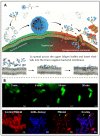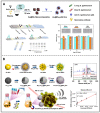Nanoparticle formulations for therapeutic delivery, pathogen imaging and theranostic applications in bacterial infections
- PMID: 37056563
- PMCID: PMC10086212
- DOI: 10.7150/thno.82790
Nanoparticle formulations for therapeutic delivery, pathogen imaging and theranostic applications in bacterial infections
Abstract
Pathogenic bacterial infections represent an ever-growing crisis, now significantly threatening life expectancy across the worldwide population and thus novel approaches to tackle this issue are urgently needed. The application of nanotechnology in recent years has opened up new horizons in the selective or specific delivery of drugs or imaging agents to infectious sites. In particular, the development of nanoparticles for both delivery of active substances and imaging of infection sites is now gathering much interest. Although still in its infancy, the field of antibacterial nanomedicines provides exciting new possibilities to combat multi-resistant bacterial infections and shows great promise for personalized medicine in antibacterial stewardship. This review examines nanoparticle-based formulations used for therapeutic delivery, pathogen tracking in diagnosis, and combined "theranostic" approaches to more effectively treating bacterial infections.
Keywords: Bacterial Infection; Diagnosis; Nanoparticles; Theranostic; Therapeutic delivery.
© The author(s).
Conflict of interest statement
Competing Interests: The authors have declared that no competing interest exists.
Figures













Similar articles
-
Ruthenium complexes/polypeptide self-assembled nanoparticles for identification of bacterial infection and targeted antibacterial research.Biomaterials. 2017 Oct;141:296-313. doi: 10.1016/j.biomaterials.2017.07.005. Epub 2017 Jul 5. Biomaterials. 2017. PMID: 28709020
-
Voyage of theranostic liposomes for imaging and therapy.J Cosmet Laser Ther. 2017 Aug;19(4):245-249. doi: 10.1080/14764172.2017.1279331. Epub 2017 Jan 31. J Cosmet Laser Ther. 2017. PMID: 28135901 Review.
-
Towards tailored management of malignant brain tumors with nanotheranostics.Acta Biomater. 2018 Jun;73:52-63. doi: 10.1016/j.actbio.2018.04.029. Epub 2018 Apr 17. Acta Biomater. 2018. PMID: 29678675 Review.
-
Recent advances in cell membrane camouflaged nanotherapeutics for the treatment of bacterial infection.Biomed Mater. 2024 May 29;19(4). doi: 10.1088/1748-605X/ad46d4. Biomed Mater. 2024. PMID: 38697197 Review.
-
Exploring the applications of hyaluronic acid-based nanoparticles for diagnosis and treatment of bacterial infections.Wiley Interdiscip Rev Nanomed Nanobiotechnol. 2022 Jul;14(4):e1799. doi: 10.1002/wnan.1799. Epub 2022 Apr 29. Wiley Interdiscip Rev Nanomed Nanobiotechnol. 2022. PMID: 35485247 Free PMC article. Review.
Cited by
-
Expanding horizons in theragnostics: from oncology to multidisciplinary applications.Radiol Med. 2025 May;130(5):613-628. doi: 10.1007/s11547-025-01971-7. Epub 2025 Mar 5. Radiol Med. 2025. PMID: 40042756 Review.
-
Gold nanomakura: nanoarchitectonics and their photothermal response in association with carrageenan hydrogels.Beilstein J Nanotechnol. 2024 Jun 7;15:678-693. doi: 10.3762/bjnano.15.56. eCollection 2024. Beilstein J Nanotechnol. 2024. PMID: 38887524 Free PMC article.
-
Phytonanoparticles as novel drug carriers for enhanced osteogenesis and osseointegration.Discov Nano. 2025 Jan 16;20(1):11. doi: 10.1186/s11671-024-04164-9. Discov Nano. 2025. PMID: 39821381 Free PMC article. Review.
-
Systematic review of antibacterial potential in calcium oxide and silicon oxide nanoparticles for clinical and environmental infection control.J Appl Biomed. 2025 Mar;23(1):1-11. doi: 10.32725/jab.2025.001. Epub 2025 Feb 10. J Appl Biomed. 2025. PMID: 40145881
-
Docetaxel Administration via Novel Hierarchical Nanoparticle Reduces Proinflammatory Cytokine Levels in Prostate Cancer Cells.Cancers (Basel). 2025 May 23;17(11):1758. doi: 10.3390/cancers17111758. Cancers (Basel). 2025. PMID: 40507238 Free PMC article.
References
-
- Fisher RA, Gollan B, Helaine S. Persistent bacterial infections and persister cells. Nat Rev Microbiol. 2017;15:453–64. - PubMed
Publication types
MeSH terms
Substances
LinkOut - more resources
Full Text Sources
Medical

